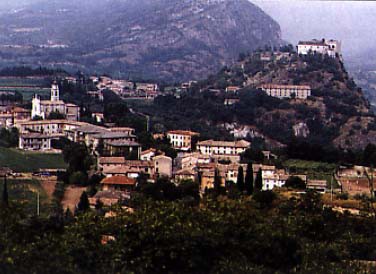Rivoli Veronese, a commune in the province of Verona of about 2000 inhabitants, stretches along the right bank of the river Adige a few miles east of Lake Garda. It sits in a landscape of precipices framed by Mont Baldo on the north and dam of the Adige. In this magnificent setting on January 14, 1797 one of the most celebrated battles of the first Italian campaign took place — the battle of Rivoli. Bonaparte seconded by Joubert and Massena brought about a spectacular victory over the Austrian troops led by Alvinczy.
Napoleon had a commemorative monument built on the battlefield, an 80-foot high column that would be torn down by the Austrians in 1814. Today a mausoleum in white stone dominates the small hill surrounded by cypresses and where a few ruins are the only legacy of what this column had once been. A commemorative plaque in French says “The soldiers of the French army in Italy 1918, and dedicated to their glorious forebears of 1797”.
On Rivoli's main street, a small museum was inaugurated in 1973 in order to present the Galanti family's collections related to the battle and the Napoleonic Legend. Francesco Maria Galanti (1765-1850) served Napoleon during the exile at Elba in 1814 and would follow him to the end of the Empire in 1815. One of his descendants, Luigi Galanti (1897-1989), was the inspiration behind the museum of Rivoli. He called his collection, “Da Rivoli al Risorgimento italiano”. The museum's mission is to celebrate the victor of Rivoli, but also to demonstrate clearly the influence of Napoleon on the history of Italy, as this statement by L. Galanti sums up: “Napoleon taught the Italians that Austria and the temporal powers of the Popes could be defeated, where prior to this they were considered taboo, invincible, and untouchable,”.
The Museo Napoleonico of Rivoli presents on its first floor two panels explaining the historical importance of the battle of January 14, 1797. Exposed on the second floor are a number of works and documents related to the arrival of Bonaparte at the head of the Italian army as well as to events that preceded Rivoli (armistice at Cherasco, battles of Lodi and Arcole), portraits of the protagonists in the battle, French and Austrian arms and engravings after Bagetti and Vernet. A model and topographical maps allow the visitor to follow the principle phases of the battle.
One section is dedicated to Venice and another to the Cisalpine Republic and the creation of the kingdom of Italy and a last section to the Risorgimento. The museum also owns a library and archival center.
Rivoli


